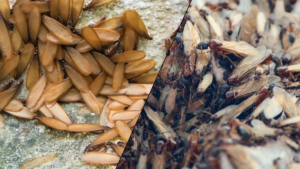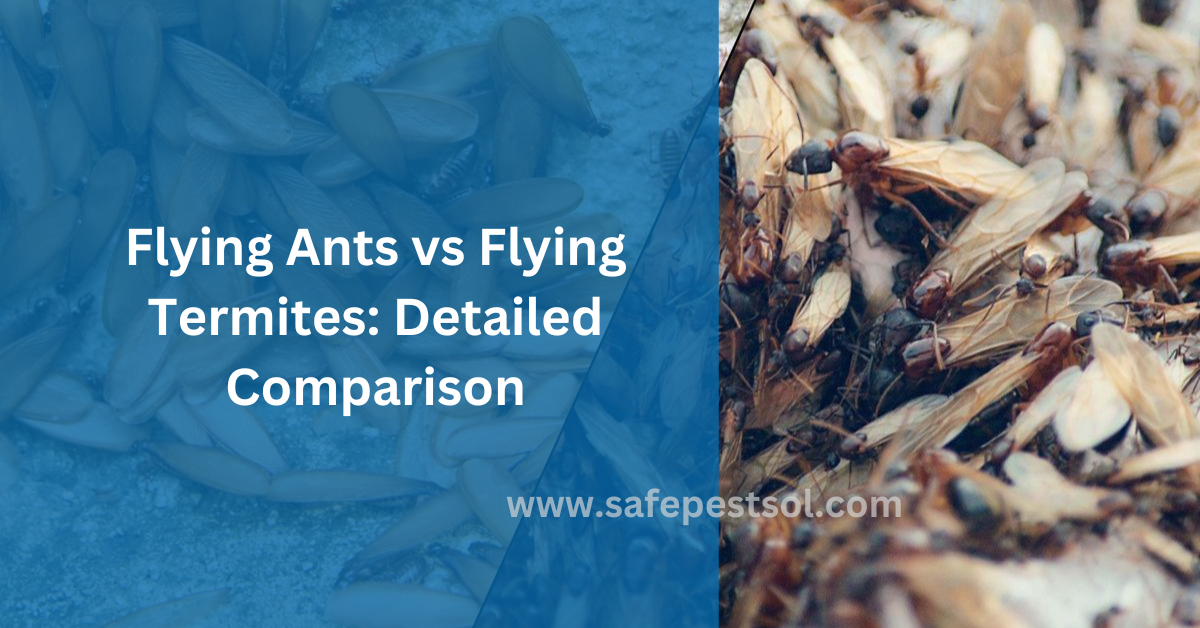Flying Ants vs. Flying Termites: Key Differences
Flying ants and flying termites are two of the most common winged insects. When you look at these two insects for the first time, you may get confused. However, they are different in their looks, behaviors, diet, and life cycles. Exploring the differences will help better identify infestations and how to manage them.

What Are Flying Ants?
Flying ants are also known as ant swarmer’s. These are reproductive ants that commonly go out of their colonies to establish new ones. They are seasonal and become evident during warm months.
Some common species of flying ants include carpenter ants. Such ants have pinched waists and elbowed antennae with front wings. Flying ants are pretty harmless. However, their ant colony becomes a nuisance if it settles in a person’s home or near food.
What Are Flying Termites?
Flying termites, or termite swarmer’s, are the reproductive members of a termite colony. They emerge in large numbers to form new colonies.
Compared to flying ants, termites can severely damage wooden structures like homes. They have a straight waist, equal-sized wings, and a straight antenna, which is different from ants. Termite infestation is a serious problem because they may cause structural damage over time.
Flying Ants vs. Flying Termites: Detailed Comparison
1. Differences in Appearances
Flying ants and flying termites may have some similarities, but their body structure is unique. In ants, the front wings are larger than the hind wings with bent antennae. On the other hand, termites have straight waists, their wings and antinnae are uniform in size.
| Feature | Flying Ants | Flying Termites |
| Waist | Pinched | Straight |
| Antennae | Bent | Straight |
| Wing Size | Front wings larger | Equal-sized wings |
| Color | Dark brown or black | Light brown or pale |
2. Differences in Behavior
Different flying ant species and termites have various behaviors. Ants are social and they work together for setting up new ant colonies. Termites showcase their swarm behavior whenever they form a colony. Flying termites seek wood to actively build their nests bigger.
| Behavior Aspect | Flying Ants | Flying Termites |
| Colony Formation | Build new ant colonies | Form new termite colonies |
| Activity | Attracted to food debris | Focused on wood damage |
| Social Traits | Cooperative | Destructive |
3. Differences in Diet
The diet of these insects reveals more differences. The flying ants mostly consume sugary substances such as nectar or debris of food. In contrast, termites mainly feed on wood and other cellulose material. This leads to a difference in the type of damage they cause to homes.
| Dietary Preference | Flying Ants | Flying Termites |
| Primary Food | Nectar, food debris | Wooden structures, cellulose |
| Damage | Minimal | Extensive damage |
4. Differences in Lifecycle
Another factor that makes these two species different is their lifecycle. Both have a queen and worker system, but ants focus on expanding their colonies above ground, while termites focus on underground or wooden nests.
| Lifecycle Stage | Flying Ants | Flying Termites |
| Colonies | Above ground | Underground or in wood |
| Queen’s Role | Lays eggs | Lays eggs |
| Workers’ Role | Build nests, gather food | Damage wooden structures |
5. Difference in Nesting Habits
The nesting habits of flying ants and flying termites differ due to their survival needs. Flying ants prefer to nest in protected areas like soil or wood cracks, whereas termites build extensive mud tubes and nests inside wooden structures.
| Nesting Aspect | Flying Ants | Flying Termites |
| Preferred Location | Soil, cracks | Wooden structures |
| Visible Signs | Minimal | Mud tubes, wood residue |
Flying Ants vs. Flying Termites: Signs of Infestation
Signs of Flying Ant Infestation
1.Discarded Wings Near Windows and Doors
Flying ants lose their wings after swarming. You would often find piles of wings around window sills or around the doors in your home. This can be a strong sign of an active ant colony nearby.
2.Food Trails and Active Worker Ants
Flying ants leave a trail leading to a food source. These trails are often created by the working ants gathering pieces of food that fall on the ground for the ant colony. If you spot regular activity close to crumbs or sugary spillage, this can be a sing of an infestation.
Signs of Flying Termite Infestation
1.Mud Tubes on Walls or Foundations
Mud tubes built by termite colonies act as protective tunnels. If you spot mud tubes along walls, foundations, or any wooden surface, it can be a sign of termite activity.
2.Hollow-Sounding Wood
Tap on any wooden furniture or construction. If it sounds hollow, then there could be damage inside the wood because of termites. Mostly, termites consume only the inner side of the wood, but the outer shell remains the same but hollow inside.
3.Presence of Termite Swarmer’s
Another strong sign is when you notice many flying termites, especially if there is any light source. This happens when the swarmer’s come out of their colonies in search of a new colony. Noticing such signs usually signals a strong infestation nearby.
How to Deal with Flying Ants vs. Flying Termites
How to Deal with Flying Ants
1.Use Ant Baits
Place ant baits close to where you notice activities. These baits attract worker ants that will take the poison back to the colony, thus effectively eliminating the infestation over time. Be sure to keep baits out of reach from children and your pets.
2.Natural Repellents Like Peppermint Oil
Pour peppermint oil in areas around the windows, doors, and places where ants fly. This remedy will repel flying ants from coming back home because it disturbs their trails of scent to avoid returning home.
How to Deal with Flying Termites
1.Seek Professional Termite Inspection
Hire a termite inspection expert. Professionals have the ability to detect active infestations and find out the degree of structural damage. They can also recommend suitable treatment. In fact, regular termite inspections will prevent long-term problems.
2.Apply Termite-Specific Treatments
Use termite-specific treatments that include bait systems or liquid termiticides, which destroy the termite colony. Such types of treatment are quite helpful for killing termites by interfering with their lifecycle to prevent further wood damage.
Conclusion
Understanding major differences between flying ants and flying termites will assist you in proper identification and appropriate treatment. By observing their specific features, behavior, diet, and nesting, you can take timely action. Whether you want ant control or want to manage termites, following the tips mentioned above will make sure to keep your home safe .
FAQs
Q1. Do I have flying ants or termites in my house?
To find out, look for differences such as body shape, antennae, and size of wings. The flying ants have curved antennae with large front wings. On the other hand, termites have straight antennae and same sized wings.
Q2. What attracts flying termites to my house?
Flying termites are attracted by wooden structures, moisture, and areas where new termite colonies can easily grow.
Q3. Can flying ants or flying termites cause structural damage?
Flying ants are harmless, but termites can cause major structural damage because they consume wooden structures over time.
Whether It is Termites or Ants, Just Call Us for Help!
Yes, you heard it right. No matter if you are dealing with bugs, ants, spiders or any other pest infestation, our team of experts are here to make your home pests-free!

